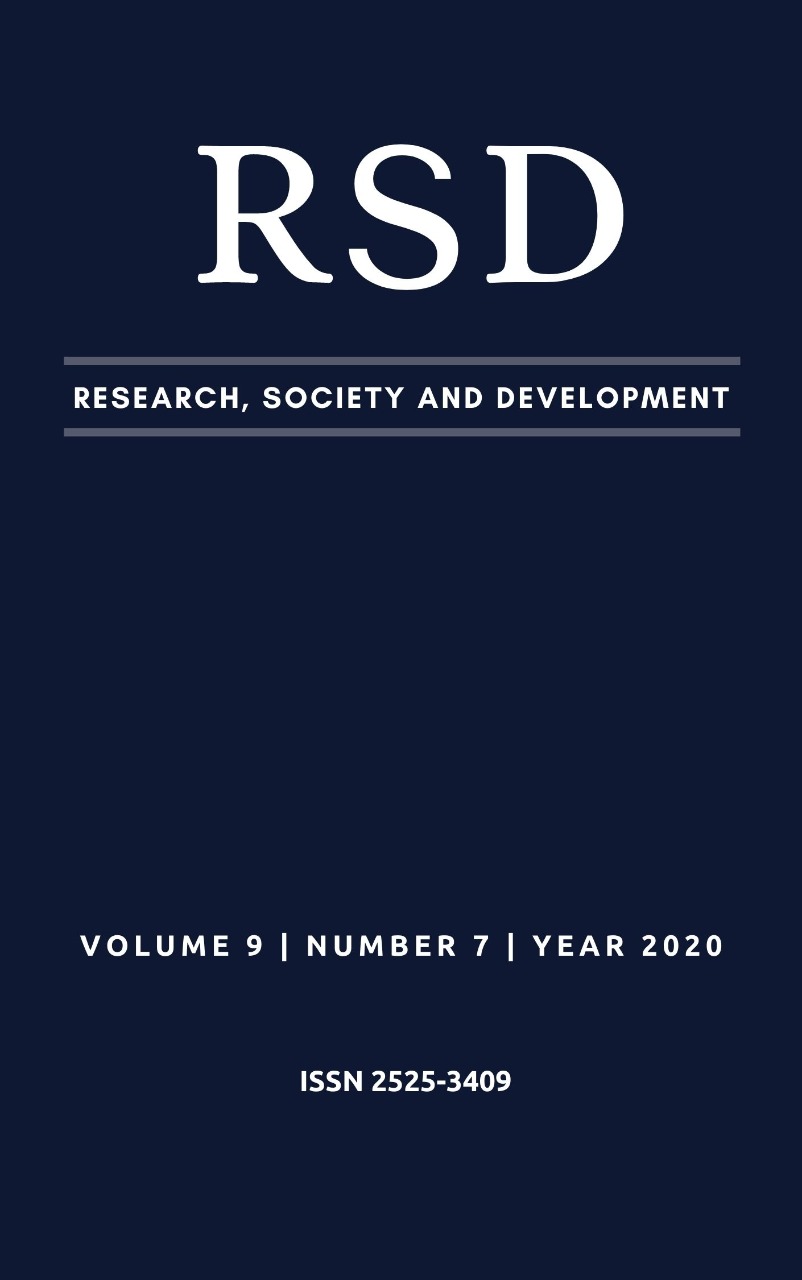Analysis of the regularity of wind velocity in Northeast Brazil through Sample Entropy
DOI:
https://doi.org/10.33448/rsd-v9i7.4746Keywords:
Regularity, Wind speed, Northeast.Abstract
The use of renewable sources has grown worldwide and in Brazil the incentive to use wind energy has been significantly expanded. The country's largest wind potential is concentrated in the Northeast (NE). The objective of this work is to measure the degree of regularity or predictability of wind velocity over Brazilian NE through the Sample Entropy method. The analyzes were carried out from the historical series of the ERA-40 reanalysis, arranged on a world grid with spatial resolution of 2,5° x 2,5° in records made at 10 m from the ground during the 00, 06, 12 and 18h during the period from 1957 to 2001. In addition to the four synoptic hours, daily, monthly and seasonal series were also generated. The results showed that the regions with higher wind speeds also present better predictability for the series. In addition, indicate that different areas with similar wind speed averages may have different predictability.
References
ABEEólica. (2020). Associação Brasileira de Energia Eólica. Acesso em 15 maio 2020, em: http://abeeolica.org.br/wp-content/uploads/2020/04/Infovento-15_PT.pdf
ANEEL. (2005). Agência Nacional de Energia Eólica. Atlas de energia elétrica do Brasil.
Amarante, O. A., Brower, M., Zack, J., & Sá, A. L. (2001). Atlas do potencial eólico brasileiro. Brasília, DF. CD-ROM.
Camelo, H. do N., Lucio, P. S., Gomes, O. M., & Leal Junior, J. B. V. (2016). Predição de velocidade do vento em municípios do Nordeste brasileiro através de regressão linear e não linear para fins de geração eólica. Revista Brasileira de Geografia Física, 9(03), 927-939.
Carneiro, T. C., & de Carvalho, P. C. M. (2015). Caracterização de potencial eólico: estudo de caso para Maracanaú (CE), Petrolina (PE) e Parnaíba (PI). Revista Brasileira de Energia Solar, 6(1). Acesso em 29 abril 2020. Disponível em: https://rbens.emnuvens.com.br/rbens/article/view/122/122.
CPTEC. (2017). Centro de Previsão de Tempo e Estudos Climático. Acesso em 15 maio 2020, em: http://www.cptec.inpe.br/noticias/imprimir/22551.
Ferreira, A. G., & da Silva Mello, N. G. (2005). Principais sistemas atmosféricos atuantes sobre a região Nordeste do Brasil e a influência dos oceanos Pacífico e Atlântico no clima da região. Revista Brasileira de Climatologia, 1(1). doi: http://dx.doi.org/10.5380/ abclima.v1i1.25215
GWEC, G. W. P. C. (2019). Global Wind Energy Outlook. Brussels.
Harper, B. R., Katz, R. W., & Harriss, R. C. (2007). Statistical methods for quantifying the effect of the El Niño southern oscillation on wind power in the Northern great plains of the United States. Wind Engineering, SAGE Publications Sage UK: London, England, 31(3), 123–137. doi: https://doi.org/10.1260/030952407781998792.
Herrera, B., & Watts, D. (2012). The Capacity Value of Wind: Foundations, Review and Applications in Chile. IEEE Latin America Transactions, 10(2), 1574-1580. doi: 10.1109/TLA.2012.6187601.
Lima, C. N. N., Fernandes, C. A. C., França, G. B., & de Matos, G. G. (2014). Estimação do Impacto do El Niño/La Niña na Intensidade dos Ventos do Nordeste Brasileiro. Anuário do Instituto de Geociências, 37(2), 232-240. doi: http://dx.doi.org/10.11137/2014_2_232_240.
Lira, M. A. T., Neto, J. M. M., Loiola, J. V. L. d., Silva, E. M. d., & Alves, J. M. B. (2017). Caracterização do regime de ventos no Piauí para o aproveitamento de energia eólica. Revista Brasileira de Meteorologia, 32(1), 77–88. doi: http://dx.doi.org/10.1590/0102-778632120150712.
Oliveira, J. L., & Costa, A. A. (2011). Estudo de variabilidade do vento em escala sazonal sobre o nordeste Brasileiro utilizando o RAMS: os casos de 1973-1974 e 1982-1983. Revista Brasileira de Meteorologia, 26(1), 53-66. doi: http://dx.doi.org/10.1590/S0102-77862011000100006.
Pincus, S. M. (1991). Approximate entropy as a measure of system complexity. Proceedings of the National Academy of Sciences, 88(6), 2297–2301. doi: https://doi.org/10.1073/pnas.88.6.2297.
Richman, J. S., & Moorman, J. R. (2000). Physiological time-series analysis using approximate entropy and sample entropy. American Journal of Physiology-Heart and Circulatory Physiology, 278(6), H2039–H2049. doi: https://doi.org/10.1152/ ajpheart.2000.278.6.H2039
Santana, L. V. R., & da Silva, A. S. A. (2019). Análise de agrupamento da velocidade do vento no Nordeste do Brasil. Sigmae, 8(2), 481-489. Acesso em 25 maio 2020. Disponível em: http://jaguar.fcav.unesp.br/RME/fasciculos/v33/v33_n3/A10_Leda_et_al.pdf.
Shepard, D. (1968). A two-dimensional interpolation function for irregularly-spaced data. In: ACM. Proceedings of the 1968 23rd ACM national conference. 517–524. doi: https://doi.org/10.1145/800186.810616.
Silva, G. F. da, Silva, A. S. A. da, & Stosic, T. (2019). Using Sample Entropy to assess complexity of wind speed dynamics. Acta Scientiarum. Technology, 41, e38954-e38954. doi: https://doi.org/10.4025/actascitechnol.v41i1.38954.
Team, R. C. (2000). A language and environment for statistical computing. R Foundation for Statistical Computing.
Vale, D., Silva, R., Rocha, E., & Alexandria, A. (2020). Zoneamento para exploração da energia eólica no Ceará com uso de sistemas de informação geográfica (SIG) e análise multicritério. Research, Society and Development, 9(7), e455973809. doi:http://dx.doi.org/10.33448/rsd-v9i7.3809
Downloads
Published
Issue
Section
License
Authors who publish with this journal agree to the following terms:
1) Authors retain copyright and grant the journal right of first publication with the work simultaneously licensed under a Creative Commons Attribution License that allows others to share the work with an acknowledgement of the work's authorship and initial publication in this journal.
2) Authors are able to enter into separate, additional contractual arrangements for the non-exclusive distribution of the journal's published version of the work (e.g., post it to an institutional repository or publish it in a book), with an acknowledgement of its initial publication in this journal.
3) Authors are permitted and encouraged to post their work online (e.g., in institutional repositories or on their website) prior to and during the submission process, as it can lead to productive exchanges, as well as earlier and greater citation of published work.


